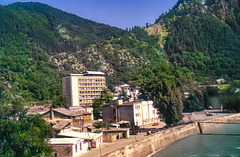
Borjomi ბორჯომი
Folder: Georgia / Sakartvelo
Borjomi is a resort town in south-central Georgia, located in the picturesque Borjomi Gorge. The town is known for its mineral water springs, diverse nature, and mineral baths. Borjomi is a year-round destination, and each season has its charms. The town is surrounded by the breathtaking nature of the Borjomi-Kharagauli National Park, which is perfect for hiking, bird watching, and amateur botany.…
(read more)
Borjomi town
| |
|
|
|
Borjomi, a resort town in south-central Georgia, was a popular destination during the Soviet era due to its mineral springs and beautiful natural surroundings. The town's mineral water, sourced from the springs of the Borjomi Gorge, is one of Georgia's largest exports and is well-known throughout the former Soviet region. During the Soviet era, Borjomi was a favorite summer resort for the aristocracy, earning it the nickname "the pearl of Caucasus"
Already in the 1860s, new hotels were built, and an administration for mineral waters was established. Following the Red Army invasion of Georgia in 1921, the Soviet regime confiscated all aristocratic mansions and turned them into sanatoria, frequented by the Communist party elite. Despite the dissolution of the Soviet Union leading to a decline in Borjomi's popularity, remnants of its socialist past can still be seen today. The town's architecture, run-down houses, and former hotels bear witness to its Soviet history. The town is now making efforts to revive its status as a leading tourist destination, with a focus on ecotourism and agrotourism.
Wild stream
| |
|
Timotesubani Monastery near Borjomi
| |
|
|
|
Timotesubani Monastery is a medieval Georgian Orthodox Christian monastic complex located in the village of Timotesubani in the Borjomi Gorge, Georgia's Samtskhe-Javakheti region. The complex consists of a series of structures built between the 11th and 18th centuries. The largest and most important building of the monastery is the Church of the Assumption of the Virgin Mary, which was built during the reign of Queen Tamar between 1184 and 1213.
The monastic complex was built with pinkish brick and includes several churches, houses for the monks, and even a church shop. To the north of the Church of the Assumption of the Virgin Mary are the remains of 10th-11th century monastic buildings and the vestiges of a hall church belonging to the 11th century. Monks' houses can be seen in the monastery's large, well-kept yard. On the upper northern terrace is a small, single-nave basilica built to commemorate Saint Barbara, the patron saint of armorers, artillerymen, military engineers, miners, and others in need of protection. To the northeast of the church, there are remains of a tomb made of stone.
The interior of the church was extensively frescoed in no later than the 1220s. Most of the frescoes have survived to this day. The frescoes were cleaned and studied by E. Privalova and colleagues in the 1970s and underwent emergency treatment and conservation with aid from the World Monuments Fund and the Samuel H. Kress Foundation in the 2000s.
A view (Daba Borjomi)
| |
|
|
Another view (Daba, Borjomi)
| |
|
|
Somewhere around Borjomi
| |
|
Borjomi-Kharagauli National Park is one of the largest in Europe. In the late 1990s, efforts were underway to establish and improve protected areas in Georgia
Somewhere around Borjomi?
| |
|
Daba - monastery
| |
|
|
Daba St. George's Church, also known as Daba Monastery, is located in the village of Daba in the Borjomi municipality, in south-central Georgia. The church is a characteristic monument of Georgian architecture of the 14th century. Despite possessing a simple plan and architectural form, Daba Church displays craftsmanship of extremely high quality, with fine ashlar facing and ample stonework decoration. The rectangular frame and ornamental motifs of the western entrance recall Seljuk architectural traditions.
This church is one of the ancient and strongest churches in Georgia, and it is nestled in a dense forest, making it not visible from the road. It is partially covered by a cave.
There is a legend associated with the church, according to which doors were made for the church several times but with no result, as they always fell down.
Jump to top
RSS feed- Latest items - Subscribe to the latest items added to this album
- ipernity © 2007-2024
- Help & Contact
|
Club news
|
About ipernity
|
History |
ipernity Club & Prices |
Guide of good conduct
Donate | Group guidelines | Privacy policy | Terms of use | Statutes | In memoria -
Facebook
Twitter








